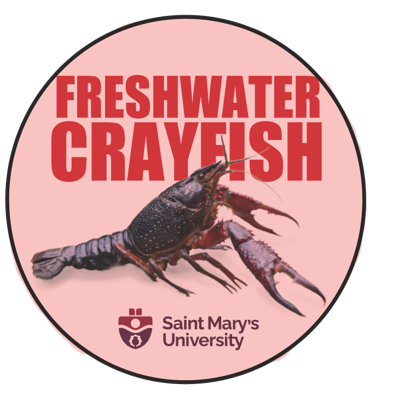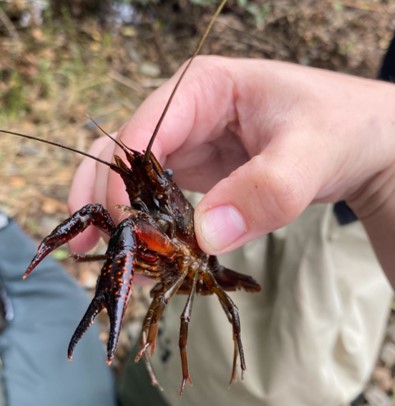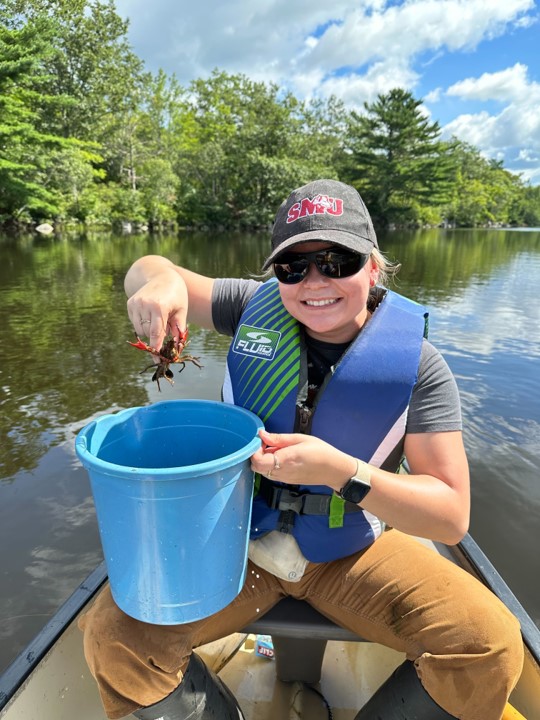Dynamic Environment & Ecosystem Health ResearchNon-indigenous crayfish in the Maritimes |
 |
Home
People
Research
Historical gold mine tailings
- Ecology & biomonitoring
- Remediation
Invasive species
- Chinese mystery snails
- Chain pickerel
- Crayfish
Publications
Teaching
Resources & Links
Lab news
Media & updates
Directions
There
are no indigenous freshwater crayfish in Nova Scotia.
- If you think you may have found crayfish in Nova Scotia, please let us know!
- Please contact Madison
Bond or the DFO Maritimes Aquatic Invasive species
by email
or phone (toll free 1-888-435-4040).
- Additionally if you have the iNaturalist app, we encourage you to add your report there.

Freshwater crayfish (Astacoidea) are closely related to marine lobsters, and there are over 330 species in North America. However, freshwater crayfish are not indigenous to Nova Scotia, Prince Edward Island, Newfoundland and Labrador. New Brunswick has 1 indigenous crayfish, the Appalachian Brook Crayfish (Cambarus bartonii), but also has several non-indigenous species throughout the province.
Invasive crayfish, specially in a region with no native crayfish ecosystems, is a concern. Many species of invasive crayfish present a significant risk because they are "ecosystem engineers" due to their significant burrowing and habitat alternation activity. This summer (August 2023), we have confirmed the presence of a new crayfish species in Waverley, Nova Scotia, and we are now verifying the species. It is most likely red swamp crayfish (Procambarus clarkii). Non-native Spiny-cheek crayfish (Orconectes limosus) was found in 2005 from Freshwater Lake, Cape Breton Highlands Park, which makes our finding the second such discovery for Nova Scotia.

We are investigating the possible presence of non-indigenous crayfish in Nova Scotia lakes in collaboration with the Aquatic Invasive Species staff at Department of Fisheries and Oceans. We are assessing trapping methodologies, eDNA monitoring and underwater videos using the Trident SOFAR underwater ROV to investigate presence and impacts of crayfish species in the Maritimes. We are also investigating the impacts of crayfish on food web ecosystems using stable isotopes ecotracers.
This page will be updated as we continue with our investigations.
RESOURCES:
DEEHR Resources
- Soon to come!
DEEHR Publications & theses
- SMU News. Student researcher has found 100 - and counting - invasive crayfish in Three Mile Lake. (Nov 7, 2023). Link.
- Red Swamp Crayfish (Procambarus clarkii) - background sheet from the Invasive Species Centre in Canada. Link.
- Parks Canada information flyer for Spinycheek crayfish in Cape Breton Highlands. Link.
- Nova Scotia Invasive Species Council. Link.
- Alien species in Nova Scotia. NS Government public communication document. Link.
- NS Fisheries & Aquaculture AIS page with links to fishing regulations and tips for preventing spread. Link.
- ECCC 2005. Wild Species Chapter 4 - Crayfishes of Canada. Link.
- Sheldon D Lambert et al. 2007. First Establishment of an Invasive Crayfish, Orconectes limosus (Rafinesque, 1817) (Decapoda, Cambaridae) in Nova Scotia, Canada. Link.
- Donald McAlpine et al. 2021. Introduction of Southern White River Crayfish (Procambarus zonangulus) to New Brunswick. ResearchGate link.
- Donald McAlpine et al. 2007. Occurrence of the potentially invasive crayfish Orconectes virulis (Decapoda, Cambridae) in eastern New Brunswick, Canada. Link.
- Donald McAlpine et al. 1999. A Range Extension for Orconestes virulis (Decapoda, Cambaridae) and a Third Crayfish Species for New Brunswick, Canada. Link.
SELECTED MEDIA MENTIONS (for full list, go to this page.)
- New invasive aquatic species found in Nova Scotia. Weather Network, Nathan Coleman (Oct 19, 2023).
- Cajun crawdads make unwelcome appearance in Nova Scotia Lake. CBC article, Paul Withers (Oct 19, 2023).
- DFO monitoring an invasive crayfish species in N. S. lake. Global News, Megan King (Oct 19, 2023).
- DFO: Red swamp crayfish trapped in Halifax area lake could have 'severe' impacts on ecosystems. Halifax Examiner, Yvette D'Entremont (Oct 19, 2023).
Headings
All images and content
copyright (c) Linda Campbell and other members of Dynamic
Environment & Ecosystem Health Research Group.
